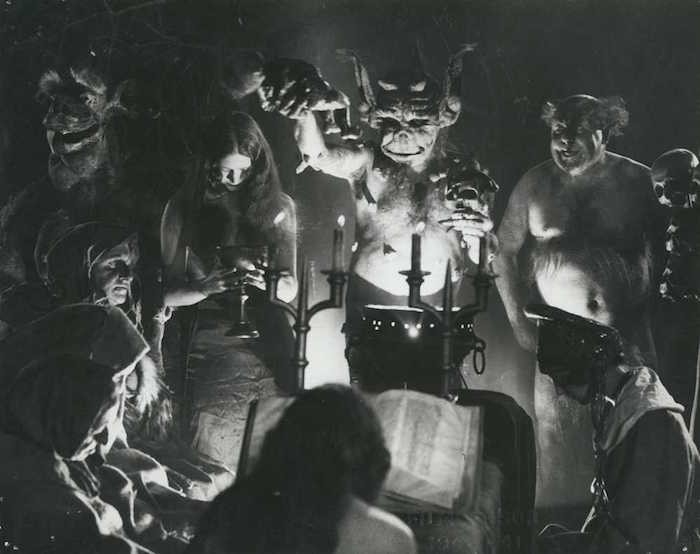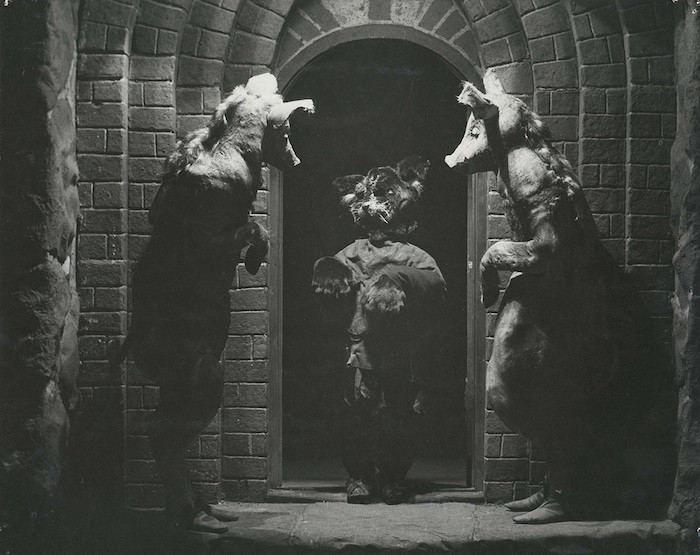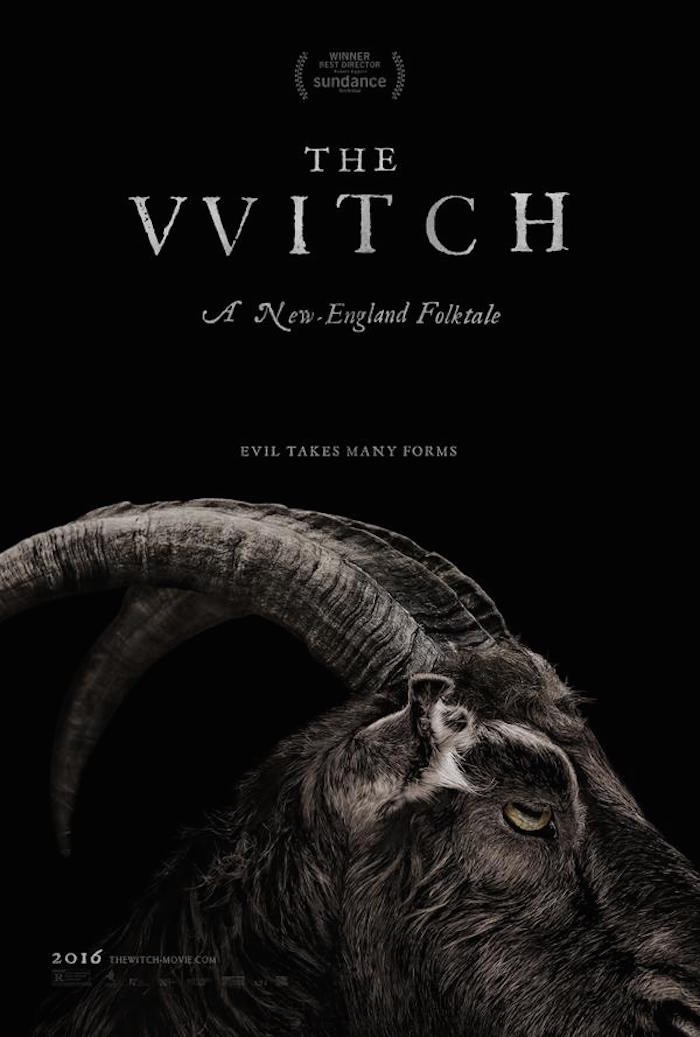The Influences Of 'The Witch' Part Two: Director Robert Eggers On 'Häxan: Witchcraft Through The Ages'
With The Witch opening this week, we sat down with writer/director Robert Eggers to do something a little different. We asked him to name the three films that most influenced his tremendous new horror movie and we would discuss his work through the lens of what inspired him. In part one of this series, we talked about Stanley Kubrick's The Shining. And now, we delve into the director Benjamin Christensen's odd and frightening silent classic Häxan: Witchcraft Through the Ages.
There really is no other film out there quite like Häxan, which blends the horror and documentary genres together in a big, boiling cauldron during an age when cinematic language was still being invented. Originally released in 1922, Benjamin Christensen's examination of superstition and religious paranoia is educational and campy, enlightening and terrifying, old-fashioned and yet, somehow, ahead of its time.
And perhaps most importantly, it gets to have its cake and eat it too: it ultimately concludes that the persecution of "witches" was the result of a male-dominated society not understanding "female hysteria," but it only gets to that point long after its indulges in extended sequences featuring Satantic rituals, monstrous demons, and depictions of Satan himself presiding over his frenzied followers. Häxan wants to explore how innocent women were tortured and coerced into admitting to literally dancing with the devil, but it also manages to create some of the most nightmarish images ever committed to film. It's a bizarre experience, but certainly a memorable one.
Because Häxan is a documentary (although not a documentary as we would understand the term today), it takes its time getting to its extended scenes of horror. Its first few chapters are essentially a history lesson, showing off medieval artist's depictions of witches at work while the the title cards fill in the details. The concluding chapters are similarly dry, jumping forward to the present day of the 1920s to explain how troubled women need help, not an inquisition. It's progressive for its time, albeit a little condescending by modern standards, but these particular scenes are more interesting as pieces of history than as cinema.
And yet, the middle of Häxan is as compelling as any other silent horror film, standing shoulder-to-shoulder with Nosferatu, The Cabinet of Dr. Caligari and The Phantom of the Opera as the finest examples of early genre filmmaking. To explore witch legends, Christensen throws us straight into them and his straightforward, classically composed depictions of some, well, really fucked up shit hit harder than most modern horror movies. The effects are crude by modern standards, but that's their appeal and their power. The practical effects and costumes have aged into the stuff of bad dreams, their unreality feeling like something torn out of a feverish sleep. You know it's fake, but you can't quite pinpoint how it's fake. It's so false that it triggers something in the back of your brain – maybe that is what a debauched and supernatural ritual in the middle of the woods would actually look like. How would you know otherwise? After all, witches as Christianity defines them don't actually exist... right?
It's easy to see how Häxan influenced The Witch (and every other witch-themed horror movie ever made). It's a barebones, straightforward depiction of the Christian view of witchcraft, which means old hags and flying brooms and magical potions. This is the witch movie template – everything that followed had to provide its own twist on this material. In the case of The Witch, writer/director Robert Eggers embraces this more traditional view rather than attempt to reinvent it and the result is a film that truly feels like a tale torn straight from another era.
Part two of my conversation with Eggers begins on the next page.
 So let's move on to Häxan. I hope I'm saying that correctly. Hacks-an?
So let's move on to Häxan. I hope I'm saying that correctly. Hacks-an?
Most people say hacks-an but I think it's hecks-an, but no one in the world is going to be upset with you for saying hacks-an.
Of the films we're talking about today, this is the one I hadn't seen before, but I had certainly heard of it. I love how it's very clearly wanting to be educational and refute the idea of witches, but it's clearly reveling in the supernatural stuff. Other than the basic subject matter, what else drove you to this movie?
I'm a big fan of silent cinema and I think that before I got into the canon of European arthouse cinema, the first interesting films I liked as a kid were German expressionist silent films. I saw a picture of Orlock [from Nosferatu] in a book about vampires in my elementary school library and was totally obsessed with the image. I needed to find a video cassette copy of that movie at all costs. That became how I got into silent cinema.
Häxan is really cool. There are a lot of things about it that are just great. I think part of it... I think the thing that is most influential about Häxan is the casting of the witches as just old women and the strength of that. There's an old woman who is being tried and tortured who was a homeless woman that the director found and her face is extremely compelling. I know that similar face is the kind of archetypal face we see in Goya and Hans Baldung Grien. That's the witch face. There was something about her face that was very sad, but that could be exploited in a way that was also very scary.
Funnily enough, it was actually the close-ups in that movie that inspired Carl Dreyer to really get into close-ups. We see this in The Passion of Joan of Arc and Dreyer's subsequent work. Weirdly, Bergman's Cries and Whispers may not be what it was if it hadn't been for that film! Häxan by way of Dreyer.
Also, there's something about silent films that I really like, which is that they don't have sound! The witches' sabbath and the images of the devil in that movie... they're campy and I don't know which version you saw [NOTE: I watched the Criterion Collection's restored cut that is streaming on Hulu]... Usually when I watch movies like that, I don't watch whatever crappy synth score is on there. I usually put on some drones or some minimal classic music. Something that will just wash over it. By not having the sounds of the witches doing their witch thing, you're finishing it with your imagination in a way that can make those primitive flying scenes and special effects really scary.
I don't think Häxan was directly responsible for this choice, but in The Witch there are many scenes which are going to emotional places that we don't go to every day. It's so extreme that the only way I could possibly articulate that was with music, so there's no diegetic sound [in those scenes]. It's like a silent film with music in those moments.
 I'm glad you already talked about those close-ups, which are so full of pain and anguish. They're amazing. Häxan also has feels like a cousin to some of the great German silent horror films, but so much of its imagery is stuff that modern culture has packaged and commodified and made safe. Witches flying on broomsticks and witches stirring potions in big cauldrons feel like jokes today, but they're treated very seriously by Häxan and very seriously by your film. How do you go about making that stuff frightening again?
I'm glad you already talked about those close-ups, which are so full of pain and anguish. They're amazing. Häxan also has feels like a cousin to some of the great German silent horror films, but so much of its imagery is stuff that modern culture has packaged and commodified and made safe. Witches flying on broomsticks and witches stirring potions in big cauldrons feel like jokes today, but they're treated very seriously by Häxan and very seriously by your film. How do you go about making that stuff frightening again?
It was a challenge, but it was fun. It was really fun. Basically, the thing is that [most people] don't know where that stuff comes from. We don't know that the witch's black cat is her familiar, which was like a demon in an animal form who sucked from extra teats on the inside of her labia. We don't know that that's what the black cat is about! It was really interesting to find out that kind of stuff.
Because of how we are taught to understand the witch holocaust in Europe and the Salem Witch Trials, it feels like these are superstitious people and people who, for political reasons were killing innocent women. This is very true. But...and I'm not saying that the mass persecution of witches had to do with a male-dominated society's misunderstanding of female power, because that's what it is. But it was manifesting itself in this idea that there were these anti-mother ogresses who could steal your children and use their entrails to help them fly on their sticks. So that's a very scary thing, you know?
It makes for a really cheeky double feature, because Häxan concludes that witchcraft isn't real that women suffered for no reason, while there is a literal, evil witch in the second scene of The Witch.
[Laughs.] I'm not saying that the witch trials were a good thing or anything like that –
Oh, I know! I'm just saying that they make for a twisted little double feature.
Cool.
Shall we jump over to Cries and Whispers now?
***
Come back tomorrow for our third and final chapter of this series, where we discuss Ingmar Bergman's Cries and Whispers.The Witch is in theaters February 19.
